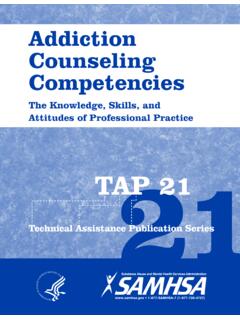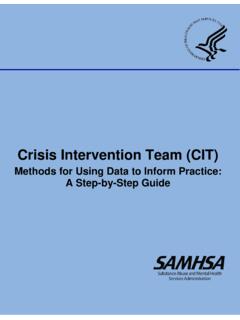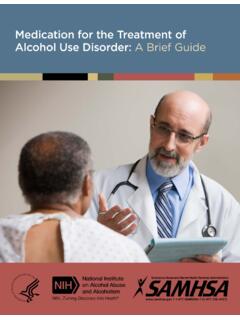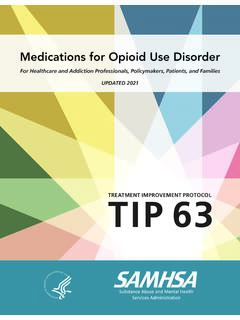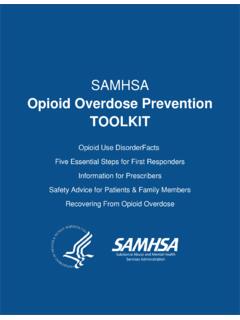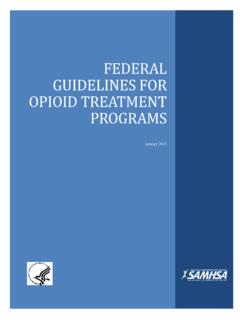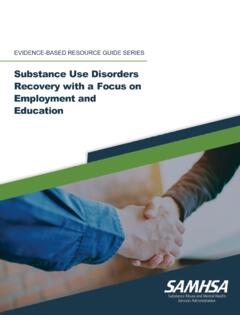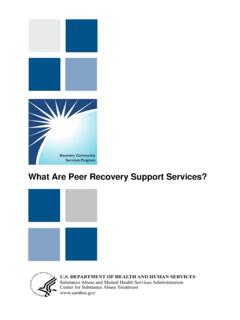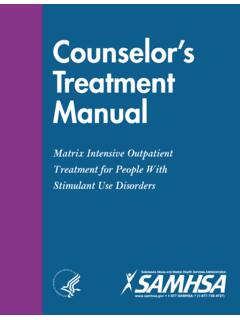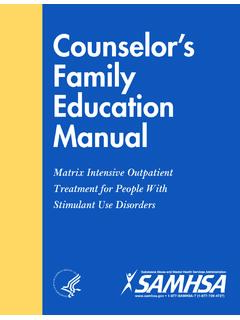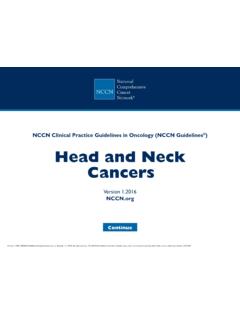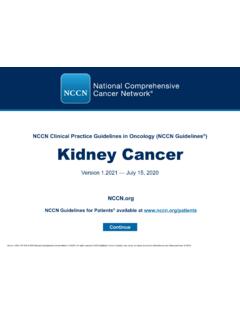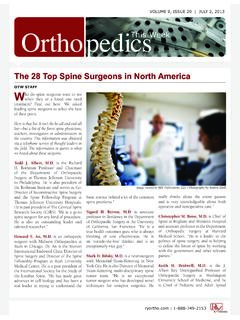Transcription of Managing Chronic Pain in Adults With or in Recovery From ...
1 A TreATmenT ImprovemenT proTocolManaging Chronic pain in Adults With or in Recovery From Substance Use DisordersTIP DEPARTMENT OF HEALTH AND HUMAN SERVICES Substance Abuse and Mental Health Services Administration center for Substance Abuse Treatment1 Choke Cherry Road Rockville, MD 20857A TreATmenT ImprovemenT proTocolManaging Chronic pain in Adults With or in Recovery From Substance Use Disorders TIP 54 ii Acknowledgments This publication was prepared for the Substance Abuse and Mental Health Services Administration (SAMHSA) by the Knowledge Application Program (KAP), a Joint Venture of The CDM Group, Inc., and JBS International, Inc., under contract numbers 270-04-7049 and 270-09-0307, with SAMHSA, Department of Health and Human Services (HHS).Christina Currier served as the Government Project Officer. Disclaimer The views, opinions, and content of this publication are those of the authors and do not neces sarily reflect the views, opinions, or policies of SAMHSA or HHS.
2 Public Domain notice All materials appearing in this volume except those taken directly from copyrighted sources are in the public domain and may be reproduced or copied without permission from SAMHSA or the authors. Citation of the source is appreciated. However, this publication may not be reproduced or distributed for a fee without the specific, written authorization of the Office of Communications, SAMHSA, HHS. electronic Access and copies of publication This publication may be ordered from SAMHSA s Publications Ordering Web page at Or, please call SAMHSA at 1-877-SAMHSA-7 (1-877-726-4727) (English and Espa ol). The document can be downloaded from the KAP Web site at recommended citation Substance Abuse and Mental Health Services Administration. Managing Chronic pain in Adults With or in Recovery From Substance Use Disorders. Treatment Improvement Protocol (TIP) Series 54. HHS Publication No. (SMA) 12-4671.
3 Rockville, MD: Substance Abuse and Mental Health Services Administration, 2011. originating office Quality Improvement and Workforce Development Branch, Division of Services Improvement, center for Substance Abuse Treatment, Substance Abuse and Mental Health Services Administration, 1 Choke Cherry Road, Rockville, MD 20857. HHS Publication No. (SMA) 12-4671 Printed 2012 iii contents Consensus Panel .. vii What Is a TIP? ..ix TIP Format ..ix TIP Development Process ..ix Foreword ..xi 1 Introduction .. 1 Chronic pain Impact .. 1 2 2 Definitions .. 2 pain and Addiction Basics .. 4 Neurobiology of 4 Chronic pain .. 6 pain s Effect on Health .. 7 Neurobiology of Addiction .. 7 Risk Factors for Addiction .. 8 9 The Cycle of Chronic pain and Addiction .. 9 Summary of TIP .. 11 Key Points .. 11 2 Patient Assessment .. 13 Elements of 13 Assessment 13 Assessing pain and Function.
4 15 Screening for Substance Use Disorders .. 20 Referring for Further Assessment .. 23 Psychiatric Comorbidities .. 24 Assessing Ability To Cope With Chronic pain .. 27 Evaluating Risk of Developing Problematic Opioid Use .. 28 Ongoing Assessment .. 30 Treatment Setting .. 31 Key Points .. 32 iv 3 Chronic pain Management .. 33 Overview of pain Management .. 33 The Treatment Team .. 33 Treating Patients in Recovery .. 35 Nonpharmacological Treatments .. 37 Treating Psychiatric Comorbidities .. 39 Opioid Therapy .. 40 Treating Patients in Medication-Assisted Recovery .. 43 Tolerance and Hyperalgesia .. 44 Treating pain in Patients Who Have Active 45 Acute pain 46 Assessing Treatment 46 Key Points .. 48 4 Managing Addiction Risk in Patients Treated With Opioids .. 49 Promoting Adherence .. 49 Urine Drug Testing .. 51 Inclusion of Family, Friends, and Others .. 54 Nonadherence.
5 54 Tools To Assess Aberrant Drug-Related 56 Documenting 58 Managing Difficult 59 Workplace Safety .. 59 Discontinuation of Opioid Therapy .. 61 Key Points .. 63 5 Patient Education and Treatment 65 The Value of Patient 65 Providing Effective 66 The Internet as a Source of Patient Education .. 68 Education 69 Opioid Information .. 69 Methadone Maintenance Therapy 71 Treatment Agreements .. 71 Key Points .. 74 v Contents Appendix A Bibliography .. 75 Appendix B Assessment Tools and Resources .. 87 Appendix C CFR Sample Consent Form and List of Personal Identifiers .. 91 Appendix D Resources for Finding Complementary and Alternative Therapy Practitioners. 93 Appendix E Field 95 Appendix F 97 99 exhibits Exhibit 1-1 Statistics on Substance Use and Chronic pain in the United States .. 1 .. 6 Exhibit 1-2 The pain 5 Exhibit 1-3 pain 2-1 Elements of a Comprehensive Patient Assessment.
6 14 Exhibit 2-2 Tools To Assess pain 17 Exhibit 2-3 Tools To Assess Several Dimensions of pain .. 18 Exhibit 2-4 Tools To Assess pain Interference With Life Activities and Functional Capacities19 ..Exhibit 2-5 Items To Include in Substance Use 20 Exhibit 2-6 DSM-IV-TR Criteria for Substance Abuse and Substance Dependence21 ..Exhibit 2-7 Steps Following Substance Abuse 22 Exhibit 2-8 Tools To Screen for Substance Use Disorders .. 22 Exhibit 2-9 Elements of Screening, Brief Intervention, and Referral to Treatment23 .. Exhibit 2-10 Federal Protection of Patient Health 24 Exhibit 2-11 Tools To Assess Emotional Distress, Anxiety, pain -Related Fear, and Depression26 ..Exhibit 2-12 Tools To Assess Coping .. 27 Exhibit 2-13 Risk of Patient s Developing Problematic Opioid 28 Exhibit 2-14 SOAPP R Questions .. 29 Exhibit 2-15 ORT .. 30 Exhibit 2-16 Elements To Document During Patient Visits.
7 31 Exhibit 3-1 Algorithm for Managing Chronic pain in Patients With 34 Exhibit 3-2 Summary of Non-Opioid Analgesics .. 35 Exhibit 3-3 Talking With Patients About Complementary and Alternative 38 Exhibit 3-4 Steps To Take If Opioid Therapy Is 41 Exhibit 3-5 Methadone Titration .. 42 Exhibit 3-6 Opioid 45 Exhibit 3-7 Treating Patients Who Have Sickle Cell Disease .. 47 Exhibit 3-8 Treating Patients Who Have HIV/AIDS .. 47 vi Exhibit 4-1 Ten Steps of Universal 49 Exhibit 4-2 Issuance of Multiple Prescriptions for Schedule II Controlled Substances .. 50 Exhibit 4-3 Talking With Patients About Medication Supply .. 51 Exhibit 4-4 POC Testing Benefits and Limitations .. 52 Exhibit 4-5 Talking With Patients About Aberrant Urine Drug Testing Results .. 53 Exhibit 4-6 Talking With Patients Who Are Resistant to Urine Drug Testing .. 55 Exhibit 4-7 Pseudoaddiction .. 56 Exhibit 4-8 Addiction Behaviors 57 Exhibit 4-9 Current Opioid Misuse Measure.
8 58 Exhibit 4-10 Resources for Information on Drug Use Trends .. 60 Exhibit 4-11 Exit 62 Exhibit 5-1 Selected Online Sources of Information on Health Literacy .. 66 Exhibit 5-2 Talking With Patients Following a Teach-Back Approach .. 67 Exhibit 5-3 Reliable Web Sites With Information on Chronic pain and pain 68 Exhibit 5-4 Reliable Web Sites With Information on Substance Use 69 Exhibit 5-5 Talking With Patients Before 70 Exhibit 5-6 Sample pain Treatment Agreement .. 73 Exhibit B-1 Tools To Assess pain Level .. 87 Exhibit B-2 Tools To Assess Several Dimensions of 87 Exhibit B-3 Tools To Assess pain Interference and Functional Capacities .. 87 Exhibit B-4 Tools To Screen for Substance Use 88 Exhibit B-5 Tools To Assess Emotional Distress, Anxiety, pain -Related Fear, and 88 Exhibit B-6 Tools To Assess 89 vii consensus panel chair Margaret Kotz, , Psychiatry and AnesthesiologyCase Western Reserve University School of Medicine Director, Addiction Recovery ServicesCase medical center University Hospitals of ClevelandCleveland, Ohio panelists Michael Clark, , Professor Department of Psychiatry and Behavioral Sciences Johns Hopkins University School of MedicineBaltimore, Maryland Peggy Compton, RN, , FAANA ssociate Professor UCLA School of Nursing Los Angeles, California Edward Covington, , Neurological center for PainNeurological InstituteCleveland Clinic Foundation Cleveland, Ohio Carmen R.
9 Green, Professor, AnesthesiologyAssociate Professor, Health Management and PolicyDirector, Health Disparities Research Michigan Institute for Clinical and Health Research Director, pain Medicine ResearchUniversity of MichiganAnn Arbor, Michigan Joseph O. Merrill, , Assistant Professor of Medicine University of WashingtonHarborview medical center Seattle, Washington Steven D. Passik, Attending PsychologistDepartment of Psychiatry and Behavioral Sciences Memorial Sloan kettering Cancer CenterAssociate Professor of Psychiatry Weill medical College of Cornell University medical CenterNew York, New York Charles A. Simpson, , DABCOVice President, medical DirectorThe CHP GroupBeaverton, Oregon ix What Is a TIp? Treatment Improvement Protocols (TIPs) are developed by the center for Substance Abuse Treatment (CSAT), part of the Substance Abuse and Mental Health Services Administration (SAMHSA) within the Department of Health and Human Services (HHS).
10 Each TIP involves the development of topic-specific best-practice guidelines for the prevention and treat ment of substance use and mental disorders. TIPs draw on the experience and knowledge of clinical, research, and administrative experts of various forms of treatment and prevention. TIPs are distributed to facilities and individuals across the country. Published TIPs can be accessed via the Internet at Although each consensus-based TIP strives to include an evidence base for the practices it recommends, SAMHSA recognizes that behavioral health is continually evolving, and research frequently lags behind the innovations pioneered in the field. A major goal of each TIP is to convey front-line information quickly but responsibly. If research supports a particular approach, citations are provided. TIp Format Most of the research that forms the evidence basis for a particular TIP is not provided in the TIP itself.
